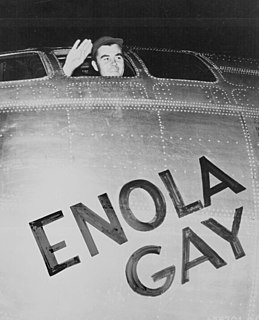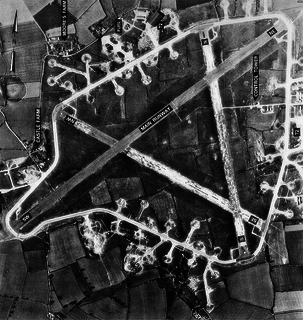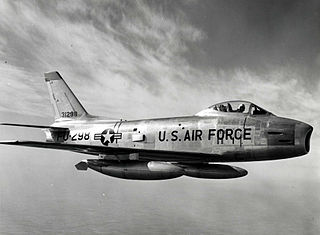
The Enola Gay is a Boeing B-29 Superfortress bomber, named after Enola Gay Tibbets, the mother of the pilot, Colonel Paul Tibbets. On 6 August 1945, during the final stages of World War II, piloted by Tibbets and Robert A. Lewis it became the first aircraft to drop an atomic bomb. The bomb, code-named "Little Boy", was targeted at the city of Hiroshima, Japan, and caused the near-complete destruction of the city. Enola Gay participated in the second atomic attack as the weather reconnaissance aircraft for the primary target of Kokura. Clouds and drifting smoke resulted in a secondary target, Nagasaki, being bombed instead.

The Martin B-26 Marauder was an American twin-engined medium bomber that saw extensive service during World War II. The B-26 was built at two locations: Baltimore, Maryland, and Omaha, Nebraska, by the Glenn L. Martin Company.

RAF Kimbolton is a former Royal Air Force station located 8 miles (13 km) west of Huntingdon, Cambridgeshire, England.

The 17th Bombardment Group is an inactive United States Air Force unit. The group was last stationed at Hurlburt Field, Florida.

Royal Air Force Station Rattlesden or more simply RAF Rattlesden is a former Royal Air Force station located 9 miles (14 km) south east of Bury St Edmunds, Suffolk, England.

Royal Air Force Andrews Field or more simply RAF Andrews Field is a former Royal Air Force station located 4 miles (6.4 km) east-northeast of Great Dunmow Essex, England.

The 19th Air Division is an inactive United States Air Force unit. Its last assignment was with Eighth Air Force at Carswell Air Force Base, Texas, where it was inactivated on 30 September 1988.

Thunderbird was a high mission tally Boeing B-17G Flying Fortress of the 303rd Bombardment Group during World War II. The original plane, serial number 42-38050, was scrapped at the end of the war and no longer exists. It is now represented by a mural in the WWII gallery of the National Air & Space Museum on the Mall in Washington, DC.

The 322d Air Expeditionary Group is a provisional United States Air Force unit assigned to the United States Air Forces in Europe. As a provisional unit, it may be activated or inactivated at any time.

The 387th Air Expeditionary Group(387 AEG) is a provisional United States Air Force unit assigned to the 386th Air Expeditionary Wing at Ali Al Salem Air Base, Kuwait under United States Air Forces Central Command (USAFCENT). As a provisional unit, it may be activated or inactivated at any time. In 2016, the groups mission was to provide support for base operations, coordination with host nation partners, and administration of the Joint Expeditionary Tasked individual augmentees in the United States Central Command (USCENTCOM) area of responsibility.

The 22d Operations Group is the operational flying component of the United States Air Force 22d Air Refueling Wing. It is stationed at McConnell Air Force Base, Kansas, and is part of Air Mobility Command (AMC)'s Eighteenth Air Force.

The 468th Bombardment Group was a World War II United States Army Air Forces combat organization. The unit served primarily in the Pacific Ocean theater and China Burma India Theater of World War II as part of Twentieth Air Force. The 468th Bomb Group's aircraft engaged in very heavy bombardment Boeing B-29 Superfortress operations against Japan. After its reassignment to the Mariana Islands in 1945, its aircraft were identified by a "I" and a triangle painted on the tail. It was inactivated on 31 March 1946.

The 38th Bombardment Group is an inactive unit of the United States Air Force. It was most recently assigned as the operational (flying) component of the 38th Bombardment Wing, stationed at Laon-Couvron Air Base, France, where it was inactivated on 8 December 1957.

The 69th Bomb Squadron is an active United States Air Force unit. After being inactivated on 31 December 1993, it was reactivated on 3 September 2009 at Minot Air Force Base, and assigned to the 5th Bomb Wing. The squadron operates Boeing B-52H Stratofortress aircraft.

The 319th Operations Group is a United States Air Force unit assigned to 319th Reconnaissance Wing Air Combat Command. It is stationed at Grand Forks Air Force Base, North Dakota operating RQ-4 Global Hawk remotely piloted aircraft (RPA) in the intelligence, surveillance and reconnaissance (ISR) role.

The 444th Bombardment Squadron is an inactive United States Air Force unit. Its last was assigned to the 320th Bombardment Wing, stationed at March Air Force Base, California. It was inactivated on 15 September 1960.

The 554th Fighter-Bomber Squadron is an inactive United States Air Force unit. It was last assigned to the 386th Fighter-Bomber Group at Bunker Hill Air Force Base, Indiana, where it was inactivated on 8 July 1957.

The 75th Bombardment Squadron is an inactive United States Air Force unit. Its last assignment was to the 4039th Strategic Wing at Griffiss Air Force Base, New York, where it was inactivated on 1 February 1963.

The 596th Bomb Squadron is an inactive United States Air Force unit. It was last assigned to the 2d Operations Group at Barksdale Air Force Base, Louisiana on 1 October 1993.

The 599th Bombardment Squadron is an inactive United States Air Force unit. It was activated at MacDill Field, Florida in April 1943. After training in the United States, it transferred to the European Theater of Operations, where it was a component of IX Bomber Command. The squadron served in combat from April 1944 until the end of World War II, earning a Distinguished Unit Citation for an attack on Ediger-Eller, Germany in December 1944 during the Battle of the Bulge. Following V-E Day the squadron remained in France until December 1945, when it returned to the United States and was inactivated at Camp Kilmer in December 1945.




















